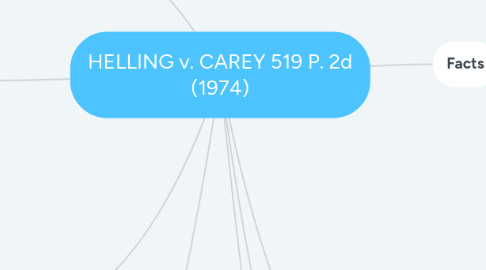
1. Rule of Law
1.1. Negligence (Malpractice)
1.1.1. Duty was established between plaintiff and defendants. Duty was breached, proximate cause of injury.
1.2. Strict Liability
1.2.1. Liability without fault, damages awarded according to the party that can best handle the financial burden. Strict liability aims to lessen suffering of the plaintiff and awards damages without assigning blame to the defendant.
1.3. Duty/Standard of Care
1.3.1. Contract established between plaintiff and defendant that requires that the doctor treat patient to the best of their ability. Patient agrees to pay provider for services.
2. Conclusion
2.1. Court overturned lower court's ruling and found in favor of the plaintiff. Found the defendants liable for negligence.
3. Application
3.1. Trial court found in favor of the defendants citing no breach of duty. The standard of care among opthomologists is to test regulary for glaucoma only after age 40. The plaintiff (32) was not a candidate for testing according to the standard of care and therefore the court found the defendents not guilty of breach of duty or malpractice.
3.2. Case then brought to appellate court, finding of trial court was reversed in favor of the plaintiff. Appellate court cited strict liability as precedent. The doctors acted within standard of care but were held liable for irreversible damage done to her vision.
3.3. Something to consider with this case though is the frequency of of Ms. Helling's visits to the defendant's office. Given that the test for glaucoma and pressure is easy to administer, non-invasive, etc,) it can be argued that the defendants did not act at the standard of care for ophthalmologists and therefore put Ms. Helling in a position where there was no chance of prevention.
4. Importance
4.1. Others would find this case and the ruling of the court important as it speaks to the need for medical professionals to be more aware when reviewing a patients complaints and perhaps be more cognizant of medical problems that could fall outside of the standard of care for the patient. Could require more work to be done by the physician to ensure nothing is missed when working with a patient.
5. Facts
5.1. Parties Involved
5.1.1. Morisson P. Helling and Barbara Helling, Plaintiff(s)
5.1.2. Thomas F. Carey and Robert C. Laughlin, Defendant(s)
5.2. Ms. Helling suffers from primary open angle glaucoma. This condition results in pressure gradually rising above the normal level to an extent in which vision can be lost and damage to the optic nerve occurs. .
5.3. In September 1963, Mr. Helling consulted the defendents regarding irritation assumed to be caused by contact lenses.
5.4. In September of 1963, Ms. Helling consulted with the defendants concerning irritation and again consulted with them multiple times over the course of 5 years.
5.5. Until a consultation in October 1968, the defendants believed the plaintiff's vision issues to be related entirely to complications associated with contact lenses. At this consultation, Dr. Carey tested the plaintiff's eye pressure and vision for the first time.
5.6. After testing for vision issues and eye pressure, it was determined that the plaintiff had glaucoma. Ms. Helling, 32 years of age, had lost her peripheral vision and her central vision was reduced.
5.7. August 1969: plaintiff filed a complaint against the defendants after consulting with other physicians. The complaint explained that the plaintiff had sustained permanent damage to her eyes as a proximate result of negligence by the defendants.
6. Impact
6.1. Other Cases Citing Helling v. Carey
6.1.1. Texas & Pacific Ry. Co. v Behymer (1903)
6.1.1.1. Cited reasonable prudence with regards to standard of care.
6.1.2. T.J. Hooper, 60 F.2d 737
6.1.2.1. Justice Hand stated reasonable prudence regarding adoption of new and available devices when referring to common prudence and standard of care.
